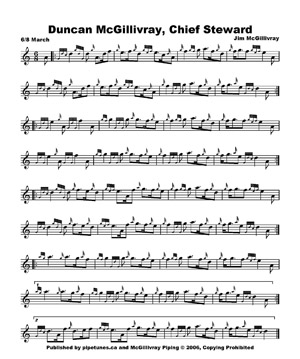A tune for Father’s Day
“Duncan McGillivray Chief Steward:” the product of an obsessed mind
By Jim McGillivray
Back in the early 1990s I wrote half a dozen tunes during a span of about two years, a couple of which have become popular. At the time, I was playing with the 78th Fraser Highlanders Pipe Band in Toronto. It was a vibrant atmosphere populated by such creative lights as Bruce Gandy, Michael Grey and Bill Livingstone. There was incentive to create tunes, because if you made a good one, it might be taken up by what was one of the most entertaining Grade 1 bands in the world.
It was this environment that drove the creation of a four-parted 6/8 march called “Duncan McGillivray, Chief Steward,” the first tune I’d written.
I don’t like writing tunes, so I don’t do it any more. They never came easily to me and were invariably built on one good idea followed by a lot of difficult, obsessive work. My tunes happened at the editing stage, and “Duncan McGillivray” set that pattern from the get-go.
The 6/8 march has always been my favourite time signature, so it seemed the best place to start. It seemed important to me that if one is going to make a tune it should be as original and interesting as possible. If it’s not original and interesting, it should go into the garbage. Lots more of my tunes went into the bin than were ever published.

Click here to listen to Jim McGillivray playing his tune, “Duncan McGillivray, Chief Steward.”
The ending came first. Somehow I got F to high G separated by a grip into my head. I couldn’t recall encountering that combination elsewhere, so I thought it an original start. The rest of the ending came right away and I liked it.
I now moved to the beginning. Clearly the ending dictated the key of ‘D.’ I diddled away on D and F on the chanter for a few seconds, trying not to play other people’s tunes, and I happened upon the D throw followed by the D strike. That usually finishes parts, so I figured why not try to start a part like that? That too seemed different.
That was the extent of my inspiration. There was no thought of a title, or even how many parts there would be. I had the ending, and the first bar, and the slogging began.
Over the course of the next three days I would be consumed by this tune, obsessing over bars, phrases and parts. I probably wrote 16 parts, maybe more. I would scratch out bars and write new ones at the bottom of the manuscript paper with long curving arrows running to and fro. If I wrote a phrase or a part and came back to it next day and thought it sounded ordinary or unoriginal, I’d work on a replacement until I had something better. I was ruthless.
I remember three eureka moments. One was the middle of the parts – bars three and four in each part – where I decided to use the ending phrase, ending on E rather than D, and replacing the grip from F to high G with a doubling. Doubling and grip would alternate between middle and ending. It was either unusual or flaky, so I took the risk and kept it. Periodically around the games I’ll hear someone playing this tune, but with either the grip or the doubling both times, rather than alternating, and it always irks me because it was a very deliberate decision to use both.
The second eureka moment came with the bouncy chain of grips that starts the second part. It seemed like a very cheerful little run (I like cheerful music) and a nice . . .

Very nice to hear the story behind this great tune. Thanks Jim!
I always loved this tune and played it often when warming up, at events and just around the house practicing. Thank you for sharing the ‘behind the scenes’ in creating this piece. I also like playing the last part best; there is something almost buoyant about the melody.
Catherine